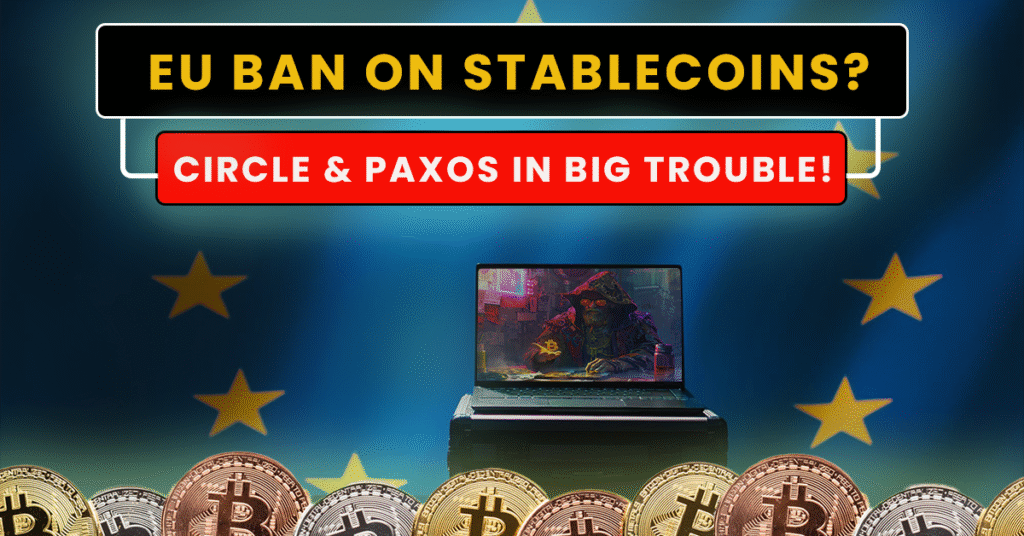
Regulatory Alarm Bells Over Stablecoin Risks
The European financial regulators, such as the European Central Bank (ECB) and the European Systemic Risk Board (ESRB), will place a precedent ban on multi-issuance stablecoins. These stablecoins are popular among the crypto and DeFi landscape, as well as major cryptocurrencies such as Bitcoin, and are viewed as the possible catalysts of market instability. The regulatory authorities of the EU are especially worried about systemic risks that would destabilise the financial system in the bloc when the market is stressed or rapid sell-offs are occurring.
Understanding Multi-Issuance Stablecoins in Crypto
Multi-issuance stablecoins are digital assets that are issued by participants within the EU and outside of it. USD Coin (USDC) by Circle and Pax Dollar (USDP) by Paxos are examples of dollar-pegged tokens that are fully incorporated into crypto trading, payments, and decentralised finance networks. Their reserve resources are geographically divided, as EU issuers reserve their resources inside the bloc, with their non-EU reserve resources being overseas to some extent in U.S. government securities.
This arrangement poses both a legal and practical difficulty in that these tokens operate identically in blockchains and crypto exchanges but within different regulatory and reserve frameworks. Regulators are worried that holders can redeem tokens preferentially in the EU in the event of market crashes, which will put pressure on local reserves and could create liquidity crises that would be reminiscent of the classic bank runs.
Impact on Major Crypto Stablecoin Issuers
The stablecoin issuers occupied by Circle and Paxos, which are the most prevalent and leading in the cryptocurrency ecosystem, can be heavily impacted. Both companies have USD-backed stablecoins that trade prominently on major exchanges and decentralised finance applications where Bitcoin and other cryptocurrencies are commonly exchanged. Their possible delisting by the EU may require entirely reorganising reserves within the EU, breaking their tokens or delisting by the European platforms.
This solution has been implemented in a complicated context in which global regulatory methods of stablecoins differ. Though the current policy of the United States, with President Donald Trump, remains the relatively crypto-friendly one, the EU is actively advancing to protect its monetary sovereignty and financial markets against cross-border risks associated with crypto assets.
The EU’s Strategic Digital Currency Vision
This action taken towards multi-issuance stablecoins is in line with the wider EU ambitions to establish a secure and sovereign system of digital currency. European banks, such as large banks like UniCredit and CaixaBank, are planning to issue a stablecoin backed by the euro, which will be regulated under an EU framework called Markets in Crypto-Assets (MiCA), with the planned launch of such a currency by 2026. This project is an attempt to provide a European alternative to the U.S. dollar-based stablecoins such as USDC and USDP, which control the largest portion of the crypto liquidity pools and trading pairs.
These regulatory initiatives are complemented by the digital euro, which is expected to become a reality as early as 2029. It is an initiative to create a single digital currency supported by the central bank that can be seamlessly adopted throughout the payment networks, ensuring the financial stability of the EU and the credibility of the crypto ecosystem in the context of the blistering development of crypto use in the world.
Broader Implications for Bitcoin and Crypto Markets
USDC and USDP are significant infrastructure of the larger cryptocurrency ecosystem, serving as safe havens whenever Bitcoin and other cryptocurrency prices rise and fall and facilitating easy crypto-to-fiat conversions on exchanges. This ecosystem will have a ripple effect on EU regulatory changes, and this will impact the liquidity, trade volumes, and accessibility to the market in Europe.
These regulations raise new challenges to those crypto investors, traders, and DeFi users who count on stablecoins to maintain a dollar-pegged stability. The hard approach taken by the EU can divide the stablecoin market, forcing users to either use compliant tokens or decentralised ones with different degrees of risk.
The push by the EU to prohibit multi-issuance stablecoins is an important inflexion point in crypto regulation and the approach to innovation and stability in digital finance. Well-established issuers of stablecoins need to respond quickly or be kicked out of the market in the EU, and euro-based digital currencies are being driven ahead by European institutions. This regulatory realignment shows that the EU is keen to take charge of digital assets related to cryptocurrency, such as Bitcoin, taking into consideration financial security and limits.
A digital marketer possessing excellent knowledge and skill in off-page, on page and local SEO is competent in the challenging environment. Hard-working, energetic, and a quick learner for any task delegated. Enthusiastic to learn and constantly upgrade knowledge. Mohit brings over 2 years of experience in crafting content that not only ranks well but also provides valuable insights to readers.

